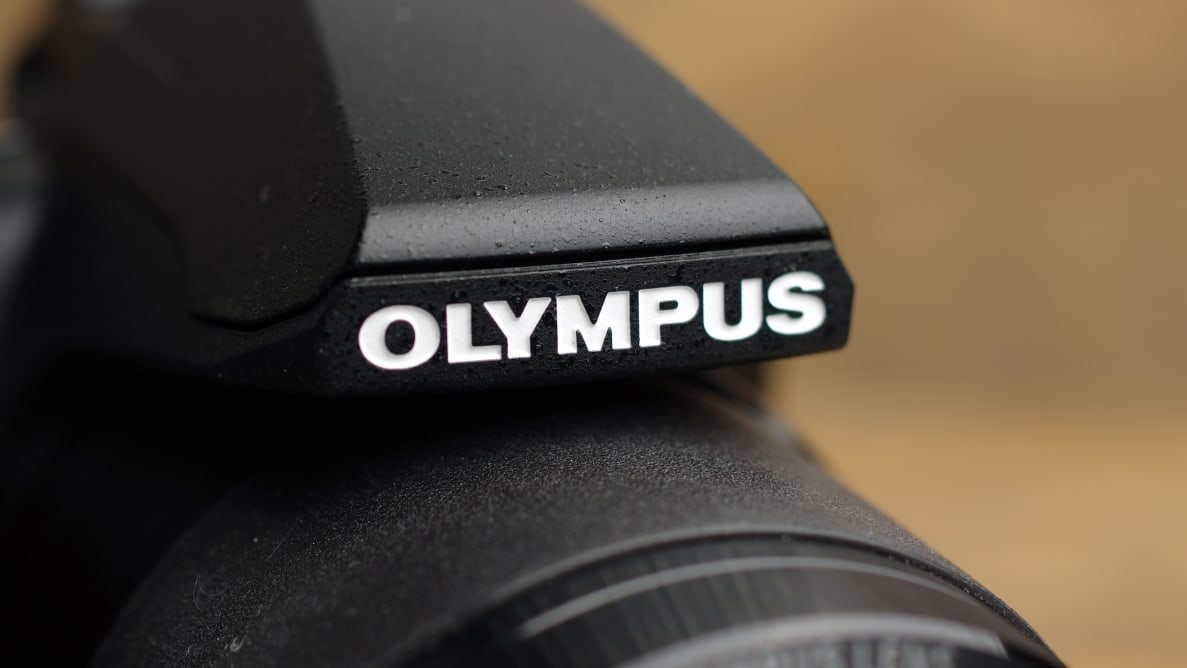Pros
Cons
The SP100-EE is a strong departure from the SP-810UZ, sporting a completely new design while upping the optical zoom to a full 50x. However, it is does have the same 1/2.3-inch sensor, a size that typically doesn't do well with such large zoom lenses. More intriguing, however, is the camera's newest design feature is on top of the camera nestled just beneath the pop-up flash; dubbed the "dotsight," it's a focusing screen with an illuminated target for framing assistance at longer focal lengths. Essentially, it's like a gunsight for your camera, which should get fans of cameras and sniper rifles equally excited. We'll cover this in a bit, but for all you Tom Berenger/Billy Zane fans out there, this one's for you.
Design & Handling
Reflects all radar
Design-wise, the SP-100EE is about as close to a F117 Nighthawk as a camera can get. It has the ability to cover great range with its 24-1200mm zoom, a start-of-the-art targeting system with the "dotsight" framing assist, and all of hard lines–perfect for staying off the enemy's radar. All of these give the SP-100EE a very clean and futuristic look, which we found aesthetically pleasing.
{{ photo_gallery name="Tour" }}
Though the design stands out from the crowd, it feels instantly familiar if you've shot with DSLRs before. The SP-100EE does a decent job of mimicking the DSLR shape, but it is not as well-built as even entry-level DSLR bodies from Canon, Nikon, or Pentax. It is mostly plastic with a rigid texture that is designed to supply increased grip. The dials and buttons are well-placed and perform well enough, though we found the shutter release a bit sticky when pressed.
Overall the camera feels like a DSLR in the hand, but it lacks the reassuring heft and the extra controls those cameras typically provide. There's only a single control dial that's recessed just a bit too far on the top plate, and the rear control-pad doesn't have a corresponding ring. The buttons are almost entirely a plastic affair, and though there's a control on the lens, it's merely a secondary zoom lever.
The strangest thing about the camera is the operation of the "dotsight" framing assist. There are two separate releases–one for the "dotsight" and one for the flash. Yet even when you release the "dotsight," it still pops the flash up—it's just not useable. It seems odd to disable the flash and have two separate releases for something that will be popped up regardless of which release you employ. Maybe there is an engineering reason for this, but if so, it isn't an apparent one.
While shooting with the SP-100EE we thought it handled well. The grip is deep enough and the camera is light enough to make handling a breeze. One element that we really enjoyed is the extra lip that is located on the rear of the camera to support the thumb. This feature of the design really locks your hand in while shooting, especially when you need to keep the camera steady.
Performance
Not quite as keen as an eagle's eye...
With Olympus making the slogan for the SP-100EE, "Keen as an eagle's eye," we were pretty excited to put this to the test. After all, eagles are renowned for their sharp vision. Yet even from the beginning we had a hunch that a super-zoom in this price bracket wouldn't quite live up to the hype. Unfortunately, we weren't wrong as the SP100-EE turned in average or worse scores in most of our lab tests.
{{ photo_gallery name="Samples" }}
That's not to say that the SP-100EE doesn't do some things well. It does offer a 50x optical zoom at a bargain bin rate, but what it gives up in sharpness hampers that offering. The images at full zoom are very soft and the image stabilization does very little to reduce the blur from those images.
That said, the "Dotsight" tool is remarkably useful and one of the best innovations we've seen in a superzoom in some time. Basically, it's a small reticle that gives you a good idea of where the center of the frame is. This means that if you're zoomed in fully on a subject and it escapes the frame, you can use the reticle to get it back in the frame without zooming too far back out. We wish the images at full zoom were better, but the dot sight works as advertised.
If you take a look at the images below, you can see exactly what I mean when I mention the loss of quality at full zoom. Even in the best of lighting conditions, you will have issues with blur and/or softness.
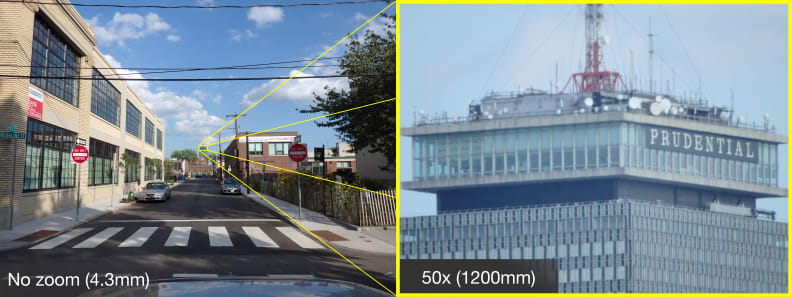
The reach of the full zoom is incredible, but the quality suffers greatly.
The 1/2.3-inch sensor is standard for most point-and-shoot cameras and is what actually allows Olympus to get the 1200mm zoom–a bigger sensor would likely provide better image quality but would also cut the zoom ratio down. However, this is ultimately the biggest hurdle for getting a quality image out of the camera. This also trickles into the noise performance of the camera, which was okay, but not overly impressive as the camera relies on aggressive noise reduction. We found that the SP-100EE could go as high as ISO 3200 without reaching an unacceptable loss in quality according to our tests. Just a quick look at Rosie below will show that you actually shouldn't venture above ISO 400 if you don't want to lose quality in the details.
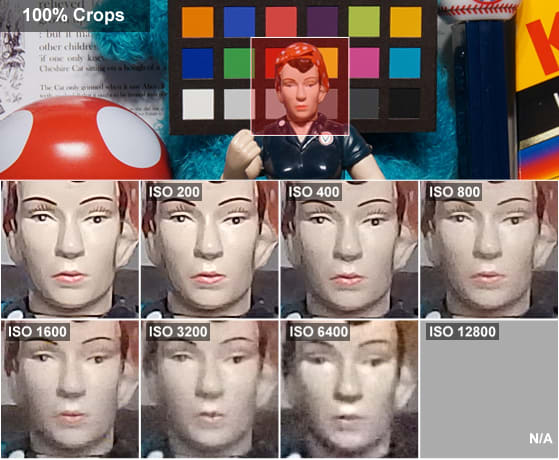
The SP-100EE handled its colors fairly well for its class. Muted ended up being the most accurate color mode–of only 3 options. The auto white balance performed rather well on most tones that we tested it with, but like most cameras, it struggled with tungsten and was most accurate in daylight.
Overall the video performance is better than your smartphone, but performance is terrible in low-light. Bright light video shot at 1080/60p was acceptable on par with your average point-and-shoot in bright light, while in low-light we saw a substantial drop in quality and sharpness. This goes back to the 1/2.3-inch sensor not allowing the sensitivity that is would need to perform in low-light. Our low light sensitivity test backed up these results, as the SP100 needed 14 lux to produce a usably bright image, on par for the category.
Features
The Call of Duty fan's dream camera
When we first got our hands on the SP100-EE at CES 2014, we immediately liked how it felt in our hands. It had a nice 50x zoom, sharp lines, a decent grip, and...a red pop-up reticle to assist you while you are zoomed in at 1200mm. What? We know, we were a bit thrown off, too. That seems like something that comes on a toy. What we found in the wild, though, was that the "dotsight" is actually a functional solution for tracking moving subjects when employing the camera's longest zoom capabilities.
Unfortunately, the photos we got from such adventures just weren't worth it. At full zoom the SP100-EE's photos just look muddled and soft, without the sharp details we would like from a dedicated camera. It's a bit of a letdown, and it ultimately undermines the entire reason for the Eagle Eye's most innovative feature; why buy a camera for its full telephoto framing features if the shots from full telephoto aren't worth the trouble?
{{ photo_gallery name="Design" }}
Outside of the "dotsight," the SP-100EE has 17 scene modes that help shooters capture the image they really want. The super-macro mode is fun to use, but you can not zoom while in that mode, reducing any chance for increased magnification. Other scene modes are useful in their given situations such as interval shooting if you want to produce a time-lapse or sunset to boost the reds and yellows of your photos. There are also seven art filters that allow you to produce iconic looks like Pop Art, Pin Hole, and Grainy Film.
Conclusion
Did you know eagle eyes aren't that sharp?
As it was clearly designed to do, the Olympus SP100-EE immediately caught our attention when we first laid hands on it. It's a handsome camera, especially considering it's all plastic and costs right around $350. The dotsight feature is an innovative, clever way of solving a common superzoom problem, and there are enough features and controls to keep most shooters happy. Unfortuantely, the SP-100EE is let down in one area: image quality.
The shots from the SP-100EE aren't dreadful—they're certainly better than your average smartphone—but they don't compete with other cameras around this price point. The sensor technology feels slightly outdated and slapping a 50x zoom lens on front simply doesn't do the camera any favors. The images are processed well, but they're soft and lack the punch that we see from Olympus' interchangeable lens Micro Four Thirds cameras.
The superzoom market is a tough nut to crack. Consumers want more and more zoom range in their cameras, but once you get past a certain point there are seriously diminishing returns on image quality. It is simply not feasible to produce a $350 camera produces great images at over 50x optical zoom. Our favorite in this category has long been the Canon SX50 HS, but even that camera has quite a bit of softness when fully zoomed in. A more practical choice would be something in the 24x zoom range, such as the Panasonic FZ200. That camera also gives you an f/2.8 aperture through the entire zoom range, preserving image quality and low light performance no matter how far your subject is from the camera.
If you do not need the extra zoom, there are plenty of cameras out there for someone looking for a camera to replace their smartphone. The Sony Cyber-shot RX100 is only a 3.6x zoom, but much better performance in all fields and currently only $498 on Amazon. The Samsung NX3000 is a great option for someone looking for a great interchangeable lens and is only $529 with a 16-55mm lens and loads of features.
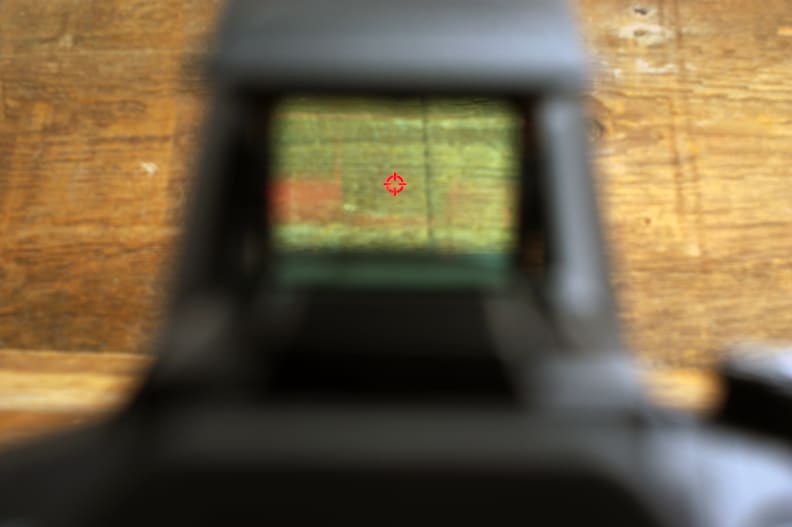
The "dotsight" helps keep track of subjects while zoomed in.
We admit that we had fun pointing the "dotsight" at various targets and pretending that we were part of an elite sniper team... However, that is about the end of the enjoyment that the SP-100EE brought. While it performed OK for the $350 price tag, we hoped for image quality that matched the dotsight's usefulness. It might be a good fit for the right shooter, but there are better places to spend your money.
By the Numbers
If you've ever heard the saying, "you get what you pay for" in your life, then you'll know what to expect from the SP-100. While Olympus did price the SP-100EE about $100 cheaper than most super-zooms on the market, it came at a cost of features and performance. It doesn't match many of the super-zooms on todays market in our lab tests, merely putting in an average performance overall. Check out what we found when we let the "eagle eye" loose in our labs.
Color and White Balance
Let's go ahead and get the best part of the results out of the way–the color performance. Color on the SP-100EE wasn't terrible at all, but it only has three modes total. The most accurate color was "Muted", which has a ∆C00 saturation error of 2.52 and overall saturation of 94.2%. That is actually spot on for what the mode is suppose to do–"Muted" is intentionally desaturated. Vivid came in at ∆C00 3.1 and 108.6% saturation. Again, the over-saturation is by design and Olympus his this mark quite well. Lastly "Natural" came in at ∆C00 2.89 and 97.5% saturation which is closer to the saturation mark than "Muted", but the ∆C00 is just too far off to be the most accurate.
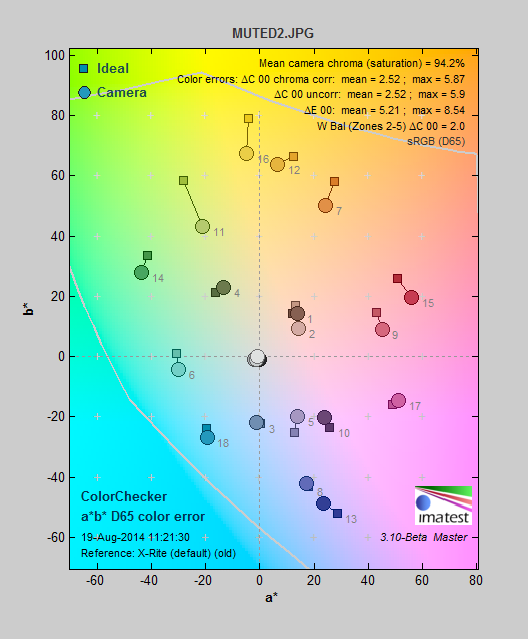
The automatic white balance performance wasn't terrible either. Fluorescent was the most accurate with a variance of about 111 kelvins, daylight was next with 150 kelvins, and incandescent was fairly far off–as most cameras struggle with this light–with a variance of 1,400 kelvins. These are all fairly normal for cameras and were actually impressive from what we saw out of the SP-100EE in other tests. It did struggle a bit on custom white balancing, which was rather odd. Incandescent light was off by about 400 kelvins even on custom settings.
Sharpness
In just about every superzoom we've tested over the years, we have been let down by the sharpness at full zoom. It simply isn't yet possible to pull off a sharp image on such a small sensor when zooming in that far. That said, the SP-100EE is simply not sharp... at all. At full zoom of 1200mm, the SP-100EE doesn't even get over 830 lw/ph. That is extremely low and if you look at the chart below–0x, 25x, and 50x zoom–you see the sharpness start plummeting immediately.
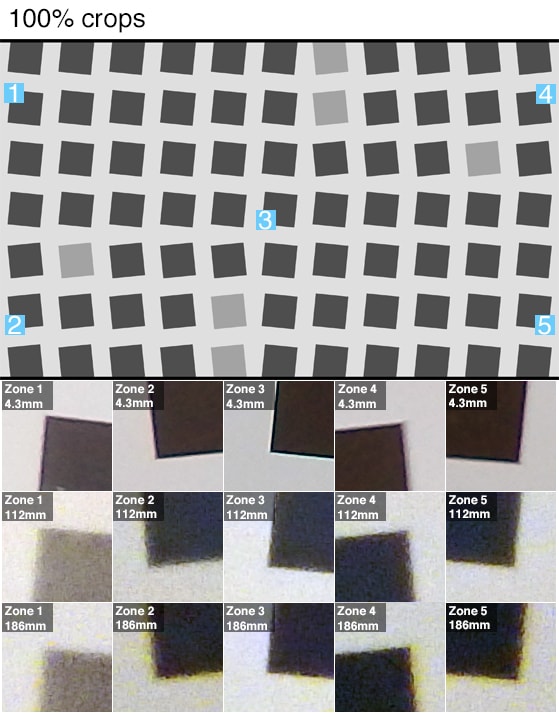
What is happening is the camera is hitting the diffraction limit around f/4-5.6. At this point the incoming light is fuzzy enough that it's impossible to render a truly sharp image. The more you close the aperture down, the worse the problem gets. Since superzooms almost all close the aperture down as they zoom in, there's a natural trade-off between more optical zoom power and worse image quality. That said, even without hitting the diffraction limit–such as the image at 4.3mm–this camera simply isn't very sharp.
Noise
Noise falls under a similar limitation as the sharpness does–sensor size. A 1/2.3-inch sensor like this simply can't perform well in low light, which is why most of these superzoom cameras struggle in this area. The SP-100EE did not come up with a magical innovation to overcome this, so it falls victim to poor noise performance like its predecessors.
If you look at Rosie below, you will notice that noise is an issue as low as ISO 400. With no control of noise reduction, you simply have to live with these and hope that you aren't in a situation where you need to shoot above ISO 400. When you do the camera tries to compensate for the noise by using software to smooth things out, but the result is too often a muddled mess where fine detail should be.

Video Performance
Video quality is actually impressive on the SP-100 given its mediocre performance on other tests. The fact that it can shoot full 1080p at 60fps certainly is an added help. The one draw back is–due to poor noise performance–you must keep the scene extremely well lit to get the best quality. There was not a lot of trailing or artifacting in bright light, but there was some frequency interference as the camera's processor struggles to keep up.
Sharpness-wise, the SP-100EE performed about average for a camera of this type and size. When we shot full-HD at 60fps in bright-light (around 1,500 lux) we only saw 400 lp/ph horizontally and 500 lp/ph vertically. We then dropped down to 60 lux for the low-light test and saw the sharpness drop to 375 lp/ph horizontally and 425 lp/ph vertically. This basically puts it in line with most smartphones, so it is useable for online sharing and such.
Meet the tester
As a photojournalist, Jackson has had stints working with bands, the military, and professional baseball teams before landing with Reviewed. Outside of Reviewed, he can be found looking for the next game to relieve his "Gamer ADD" or growing his beard.
Checking our work.
Our team is here to help you buy the best stuff and love what you own. Our writers, editors, and experts obsess over the products we cover to make sure you're confident and satisfied. Have a different opinion about something we recommend? Email us and we'll compare notes.
Shoot us an email